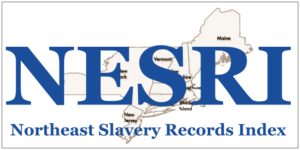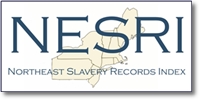 “Did slavery happen where I live?” If someone asks that question, NESRI can present the answer, with evidence.
“Did slavery happen where I live?” If someone asks that question, NESRI can present the answer, with evidence.
The Northeast Slavery Records Index (NESRI) is an online searchable compilation of records that identify individual enslaved persons and enslavers in the states of New York, Maine, New Hampshire, Vermont, Massachusetts, Rhode Island, Connecticut and New Jersey. NESRI indexes census records, slave trade transactions, cemetery records, birth certifications, manumissions, ship inventories, newspaper accounts, private narratives, legal documents and many other sources. NESRI produces online search reports to assemble and present all of our records related to any state, county, town or city in the NESRI states
Education is central to achieving our goal to deepen the understanding of slavery in the northeast United States by bringing together information that until now has been largely disconnected and difficult to access. Our strategy is to support K-12 and higher education teachers and professors as their integrate the study of enslavement in courses and curricula.
Resources of Educators
There are many excellent resources for educators seeking to integrate the study of slavery into courses and curricula. The following are some examples.
- National Museum of African American History and Culture
- Freedom on the Move
- Slavery In New York
- Atlantic Black Box
- Freedom Center
- Monmouth University Social Justice Academy
- American Academy of Arts and Sciences: Our Common Purpose
The Role of the Northeast Slavery Records Index
While NESRI scholars will eventually develop specialized curricular and learning activity packages featuring insights from enslavement records, our initial goal is to enhance the courses, learning packages and curricula or other organizations, particularly our partner organizations. This can be accomplished by enhancing content for projects, providing models and templates for records-base research, providing meta-analytic tools for records-based research, and supporting hands-on research by students and community volunteers.
Enhancing Content: The following are ways that NESRI can enhance the content of education projects.
- NESRI can focus study and discussion based on locations and places. Not only can this motivate students, but it is a critically important understanding in the northeast where many people believe that slavery took place only in the southern states.
- Studying enslavement in different places and times enhances understanding of the processes of enslavement, including investment, shipping and trading, and the modalities of resistance to enslavement.
- NESRI can support comparative studies of communities in different states, such as the processes of gradual abolition in Connecticut, New Jersey and New York. Why did the same legal strategy result in such different outcomes?
- NESRI can focus on individuals and groups (especially church congregations) as they evolved from enslavement to abolition.
Models for Records-Based Research: NESRI also has articles on the site that can serve as models for research reports based on enslavement records. The following are examples:
- The Art of Enslavement identifies sculptures, memorials and portraits depicting enslavers, on display in art galleries and parks.
- Slavery and the New York State Legislature documents that, at the time the gradual emancipation law was passed in New York State, the majority of New York State Senators were enslavers.
- How Religious Institutions Can Study and Redress Historical Enslavement presents a conceptual model for inquiries into past slavery associated with religious institutions.
- Born in New York – Traded in Louisiana identifies the records of trades, in Louisiana, of 32 persons who are identified in the sale record as having been born in New York
Meta-Analysis of Enslavement Across Jurisdictions: NESRI also has a Topical Search feature based on “tags” that identify records, within and across jurisdictions, based on issues and themes. The following are examples of the search tags.
- BON: These are records of slaves who escaped to the British during the Revolutionary War and who subsequently emigrated to Canada as free persons.
- LSTD: The are records of slave transactions in Louisiana where the enslaved person was born in New York. Their enslavement in Louisiana may have been illegal in New York.
- SJTR: These are records on enslaved persons and owners identified in Sojourner Truth’s biography. We have an essay explaining these records.
- FGT: These are records based on runaway slave notices and ads.
- FSO: Enslavers who were women.
- ABN: These are records of babies born to enslaved women who were officially abandoned by the slave owner and placed up for foster care by the local government.
- SALE: This is a record of a slave trade transaction.
- EMN: This is a record of an emancipation of a slave.
- CEM: A cemetery marker or record.
- SEN: Tags starting with SEN followed by a year identify slave owners who were members of the New York State Senate for the year specified. We have an essay explaining that a majority of Senators in the 1790 and 1800 Senate owned slaves.
- JAY: Slavery and the extended family of John Jay.
- SHIP: A record of a vessel transporting enslaved people.
- INVNY: This tag identifies a New Yorker investing in a slave ship delivering enslaved people to New York.
- INVI: This tag identifies a person not from New York (typically from Europe or the Caribbean) investing in a slave ship delivering enslaved people to New York.
- HOUSE: This tag identifies a record associated with a residence that still exists today.
- RAIL: This is a record of a person enslaved in a southern state arriving in New York seeking freedom.
- CMPT: This is a record of the NY State Comptroller’s Office compensating towns and cities for the costs of care for abandoned slave children.
- ADV: The record contains the name of a person who tried, in a direct and individual way, to advance or preserve the freedom of the enslaved person.
- LEGAL: The record involves a legal case or trial.
Mentored Hands-On Research: Because the NESRI database constantly grows and is never complete, there are opportunities for students and community-based volunteers to undertake research activities that uncover more records in more communities. These activities can be integrated into courses involving methods of research in the social sciences and humanities, or students and volunteer can take on projects outside of their studies and be guided by NESRI partners. All of this research culminates in the addition of records of enslavement to the NESRI database. The following are some examples of techniques.
- Archives: Researchers can discover archives in governmental and historical association archives and index them for the NESRI dataset. The records can at the same time be digitally scanned.
- Locality Research: Researchers can identify communities and focus on expanding awareness and conservation of enslavement records in the communities. At standard technique is to produce a locality database report for a county, identify the types of records indexed from localities with deeply indexed collection, and then select other comparable communities from the same county that do not have similar records in the NESRI database. The researcher then contacts local librarians, archivists and public officials such as town clerks to locate and index the missing records.
- Genealogical Research: The NESRI database identifies many parent-child-sibling relationships among enslaved people. Genealogical relationships for enslaved and emancipated people in the 1700s and 1800s need to by systematically documented to more completely describe the lives of enslaved people, and also to prepare for genealogical inquiries working back from the 1900s through the late 1800s.
- Syncing Silos: NESRI has records that document events of individuals over time and place. However, because the records come from different archives and collections and source, the fact that as et of records relate to the same person needs to be actively determined and coded with a unique identifier for each enslaved person. This is especially important when an enslaved person is traded across state lines. This work provides an ideal opportunity for individual students and volunteers to practice multi-disciplinary research skills.
While NESRI scholars will eventually develop specialized curricular and learning activity packages featuring insights from enslavement records, our initial goal is to enhance the courses, learning packages and curricula or other organizations, particularly our partner organizations.



